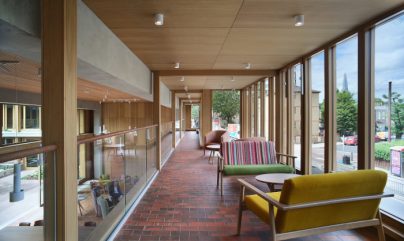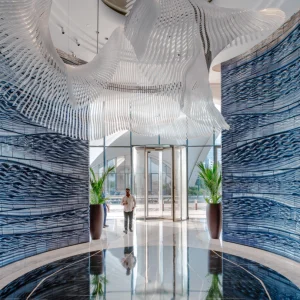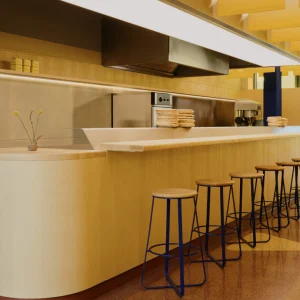
JUST OVER A DECADE AGO, I was sitting in a crowded auditorium at a European Healthcare Design conference, listening to a Danish architect describing an exemplary project for ‘later life’ living, paid for by local government, that he had just completed in Copenhagen. You could almost hear – and definitely feel – the collective sigh of envy at the spacious, lightfilled apartments with deep windows looking onto individual balconies and lush, landscaped shared gardens, which emanated from myself and the rest of the delegates. At the time the UK’s default options ranged from unlovely nursing homes, or blocks of small, sheltered apartments in cities or towns, or – at the more luxurious end – privately funded, gated communities located miles from anywhere and thus minimising intergenerational connection and support.
Image Credit: Philip Vile
Fast forward to 2023, and a very similarly covetous atmosphere was generated among the London architecture media on a first visit to Appleby Blue, an almshouse-inspired scheme by Witherford Watson Mann (WWM), in a densely residential part of Southwark. This is not a council-funded scheme, though Southwark Council has gifted the land to the client, United St Saviour’s Charity (UStSC), and helped to broker additional funding through a Section 106 agreement with developer JTRE (which didn’t want to include affordable housing next to its development, 185 Bankside, behind Tate Modern; Southwark was happy for that investment to land here).
 Image Credit: Philip Vile
Image Credit: Philip Vile
Established 500 years ago, UStSC has a long history of housing communities in need in Southwark, including building the borough’s first almshouse in 1588. What’s more, its head of research and influence, Alison Benzimra, has found convincing evidence, as co-author of the ‘Almshouse Longevity Study’ (Bayes Business School, May 2023), that living in an almshouse can boost residents’ lifespans by as much as two and a half years.
 Image Credit: Jim Stephenson
Image Credit: Jim Stephenson
The almshouse is a particularly relevant design for these times, when loneliness – especially in ageing populations – is said to have a greater negative impact on our life expectancy than obesity, depleting both physical and mental health. Designed around a shared courtyard or garden, and thus creating a safe central circulation space with built-in visibility and sociability, the almshouse promotes a high degree of community interaction. But post pandemic, loneliness and isolation are two of the biggest problems facing society in general. For the ageing in particular, part of that isolation comes from a lack of engagement not just with peers but also with other age groups. This is something Appleby Blue’s design, and its programming, are trying to address. ‘The lounge and the community kitchen will be used by everyone in the neighbourhood, bringing generations together,’ said Martin Craddock, chief executive of UStSC, at the launch. ‘Older people here want to feel they are part of the community and can be seen to contribute to it.’
 Image Credit: Jim Stephenson
Image Credit: Jim Stephenson
The design of the home is one of three key platforms for the Appleby Blue model, says Benzimra, with resident support and community engagement playing equally important roles. The aim is to keep residents active and socialising with programmed events such as regular film nights, community gardening in the rooftop garden, as well as themed activities around food and cooking, which are also open to the local community. Researcher Dr Sophia Amenyah is in charge of this activity strand, through the programme she runs at Bournemouth University, and the Lemonade Community Food Model for Older People. Craddock concluded: ‘This is what social housing for older people in inner cities should be.’
 Image Credit: Jim Stephenson
Image Credit: Jim Stephenson
 Image Credit: David Butler
Image Credit: David Butler
In another sign of progress for the UK landscape, in 2023, a later living building won the RIBA Stirling Prize for the first time in the award’s history, given to Mae Architects’ inspirational John Morden day care centre at Morden College retirement home in Greenwich (see case study).
 Image Credit: David Butler
Image Credit: David Butler
 Image Credit: David Butler
Image Credit: David Butler
Alex Ely, founder and director of Mae Architects, has several projects on the go for this demographic. He is particularly interested in the ‘active elderly’ and how their contribution to the city can be activated and integrated through new housing models. He says: ‘It’s this portion of society, usually aged 60 to 74, who are active in the sense that they may have retired from work but are fully mobile, are available and interested to engage in leisure and cultural pursuits. There’s also evidence that many of them are taking on roles mentoring and supporting younger businesses, contributing to society through community activities and social infrastructure. Those that are more affluent, and have financial security, have time on their hands and wish to remain active members of society.’
 Other than the garden there is a lack of shared facilities at Dovehouse so that residents make use of the village’s retail, hospitality and community offer. Image Credit: David Butler
Other than the garden there is a lack of shared facilities at Dovehouse so that residents make use of the village’s retail, hospitality and community offer. Image Credit: David Butler
To this end, the practice has worked with both local authorities and private later life housing providers such as PegasusLife (now Lifestory) to build accommodation around community or commercial facilities that will encourage interaction. For Westminster City Council Mae recently completed a Community Supported Housing apartment block, Daventry House, in Lisson Grove that sits above a 1,300m2 enterprise centre, envisioning possible roles for the older residents as mentors and coaches for young entrepreneurs.
 Image Credit: Riikka Kantinkoski
Image Credit: Riikka Kantinkoski
For Southwark Council, Mae Architects has completed the Harriet Hardy extra care home, with 119 new council homes arranged in an almshouse-style horseshoe around a southfacing courtyard. Designed for a range of abilities, needs and also ages, 54 of the flats are extra care apartments; the idea is that Southwark residents will be able to stay in place, and in their communities, for many decades. Meanwhile, in East Ham, for the London Borough of Newham, Mae is at work on Noele Gordon House, an ambitious scheme of 75 one and two-bed apartments available for affordable rent, split into two medium-rise blocks, arranged around a shared roof garden and communal areas, with a community health centre with two GP surgeries on the ground and first floor.
Elsewhere in the UK, Mole Architects has just completed an almshouse scheme in the village of Girton (see case study) and is drawing up another scheme for Cambridge Council set right in the heart of the city – just behind the legendary gallery, Kettle’s Yard.
 Image Credit: Riikka Kantinkoski
Image Credit: Riikka Kantinkoski
RCKa, like Mae Architects, has been working closely for some time with both local authority and private later living housing providers, and is trying to incorporate the almshouse typology where possible, in a variety of schemes.
RCKa has successfully persuaded its client Retirement Village Group (RVG) that prioritising placemaking and thoughtful landscaping as well as sociability and connectivity is the way to build longevity and well-being into its schemes, as witnessed in RCKa’s first scheme for RVG, Wyldewood. And now the practice is integrating almshouse typologies into new schemes for this private developer turned developer/operator, going through planning at West Malling in Kent as well as one in Essex, at Froghall Lane, Chinwell. Both former greenbelt sites, RCKa has varied positions, typologies and landscaping to create points of distinctiveness and interest, drawing residents and visitors into and through the sites.
 Image Credit: Riikka Kantinkoski
Image Credit: Riikka Kantinkoski
With schemes of the quality and ambition featured here, one hopes that UStSC’s Craddock is right when he predicted: ‘If you build something of exceptional quality, people are quite happy to give up their big family homes and move in.’ But it’s interesting to note that the Scandinavians are still leading the way, on aesthetics as well as sustainability – retrofitting listed 1970s modernist corporate buildings as aspirational later life apartments (see Villa Vuoranta case study).
CASE STUDY – APPLEBY BLUE
 Image Credit: Philipp Ebeling
Image Credit: Philipp Ebeling
Appleby Blue is an exciting step forward in affordable later living, offering 57 apartments around a central, planted courtyard, with the design and programming all oriented to maximise engagement within the community but also extending out to the surrounding neighbourhood. Working to an enlightened brief from client United Saint Saviour’s Charity (UStSC), on land donated by Southwark Council, architects Witherford Watson Mann (WWM) have placed key social spaces along the ground floor, one whole length of which fronts onto a busy Southwark high street. There are workshop spaces and a community kitchen adjoining a double-height Garden Room (dining space and lounge space, with open kitchen) offering views and access directly through to the lush courtyard garden, designed by Grant Associates, which also designed the delightful, and productive, roof terrace filled with easily accessed planters.

Integral to the programming is a range of activities and events around intergenerational cooking and sharing, as well as gardening. There is also a library area and skills room, where residents and neighbours can join in activities from crocheting to digital skills sessions.
But most remarkable of all is the civic and generous spirit expressed by the design, the scale and the materials throughout the building, from the traditional brick envelope that tones sympathetically with the adjacent Victorian streets to the solid oak-framed windows on every floor bringing daylight and fresh air into the glazed circulation spaces that face onto the courtyard (sliding panels give easy access to fresh air and sunshine, even for those who can’t or don’t want to venture outside).
The accommodation is arranged around this courtyard, at varying levels, four storeys along the high street dropping down to two at the rear, where the roof terrace sits, to allow more sunshine into both the courtyard and opposite elevation. Apartments are all dual aspect, with generous interiors. All materials convey durability and quality, including precast concrete, brick and solid oak. Around 35% of the building’s energy will be generated on site by rooftop photovoltaics. Otherwise the building is designed to be passively ventilated, with common areas equipped with an automated system of opening vents.
WWM director Stephen Witherford says: ‘We hope we have made a model of older peoples’ housing that is the very opposite of a retreat. It is open, engaging. It enables a proper network of different organisations and communities. It’s a project that’s about the city and older people’s role in the city.’
Client United Saint Saviour’s Charity
Architect Witherford Watson Mann Architects
Area 2,875m2 and 5,800m2
Cost £25.1m
Landscape design Grant Associates
CASE STUDY – JOHN MORDEN DAYCARE CENTRE
To the delight of many, Mae Architects won the RIBA Stirling Prize in 2023 for the John Morden Centre (JMC), an uplifting daycare centre within a historic and landscaped setting for the social, cultural and health benefits of the 300 or so retirees who live around it.
Morden College is a charitable provider of later life housing for professionals in reduced circumstances, set on a campus in Blackheath that includes a building attributed to the legendary Sir Christopher Wren. Built in 1695 by Sir John Morden to house destitute seamen returned from overseas, the scheme has subsequently expanded, but in a piecemeal fashion, to spread across two adjacent sites. The JMC was designed to bring all shared activities into the heart of the campus, in a building that is sympathetic to the Wren building and its cloisters. For the initial vision, CEO David Rutherford-Jones had been inspired by the transformational impact on patient experience of the Maggie’s cancer caring buildings and asked Mae Architects to respond in that spirit. It did so – and how – by creating a tranquil, contemporary oasis through a sequence of brick-faced, timber-lined, CLT-framed, pavilions arranged along a wooden colonnade.
Featuring workshops, arts space, café, library and medical centre, the JMC now forms a welcoming, sociable heart to the community, alleviating loneliness and isolation. Practice founder and director Alex Mae says that journeys to and through the building are key, with integral seating provided at many points for those in need of rest: ‘The aim was to make circulation… a joyous experience. You can sit and relax and enjoy the passing of the day, or inclement weather, catch up with friends. Part of the strength of the building is that… there are visual clues as to what’s going on so it encourages residents to take part.’
Client Morden College
Architects Mae Architects
GIA 911m2
Completed 2021
Contractor Clive Graham Associates
Structural engineer Michael Hadi Associates
Interior design Scott-Masson Interior Design
Landscape architect J&L Gibbons
CASE STUDY – DOVEHOUSE COURT

Mole Architects has built a charming Passivhaus almshouse development in the village of Girton, on the outskirts of Cambridge. Three low-rise buildings are arranged in a horseshoe formation around a landscaped communal courtyard to offer 15 welcoming, energy-efficient, one-and-a-half bedroom homes for the over 55s, all of whom have either lived, worked or have family in the village. Girton Town Charity, which commissioned the buildings, was established in 1521 and now runs several almshouses for Girton residents at various stages in their lives.
The five bungalows and ten apartments are arranged as three two-storey ‘houses’. One offers six 65.4m2 apartments facing onto the high street, with lift access, a two-storey block of four 62.6m2 apartments is at the rear of the site, with a third ‘house’ of five single-storey bungalows to one side. All feature a mix of white bricks and white rendering and black matte clay roof tiles, thus blending in with the surrounding Girton architecture. Individually coloured entrance doors help with navigability.
Community and sustainability were also key to the design. Dovehouse Court uses a prefabricated timber structure, with a ‘fabric first’ approach prioritising natural materials to boost energy efficiency and durability. Large windows provide ample daylight to these dual-aspect dwellings, and sightlines maximise legibility into and beyond the scheme, mediating carefully between sociability and privacy. Through minimising corridors and incorporating a robust, metal external staircase, more space has been allocated to apartment interiors.
Each home has one bedroom and bathroom, open-access living and dining room, and a half bedroom that can be used for study, a guest or a carer. Each ground floor resident has a small private terrace, with a shared deck for first floor residents, and shared access to the south-facing communal gardens, which include an orchard and vegetable garden. Primary access is via a parking courtyard for cars and bikes with a secure footpath entrance. The planting scheme, designed by Jamie Buchanan Landscape Architect, maximises biodiversity and year-round interest.
A key move, in terms of knitting the scheme into the community, is the lack of shared facilities other than the garden, because the charity wants to ensure that residents make full use of the village’s existing, vibrant retail, hospitality and community offer.
Despite complicated changes in level across the site, the scheme has successfully met Passivhaus standards. It is fully electric, powered by an air source heat pump, and hot water generation and mechanical ventilation with heat recovery (MVHR) systems mean that the homes are supremely efficient but also well ventilated.
Client Girton Town Charity
Architects Mole Architects
Area (996m2 internal)
Value £5m
Funding Cambridge & Peterborough Combined Housing Programme provided grant of £675,000 Contractor Barnes Construction
Structural engineer Conisbee
Landscape Jamie Buchanan Landscape Architect
CASE STUDY – VILLA VUORANTA
 Image Credit: Riikka Kantinkoski
Image Credit: Riikka Kantinkoski
A mid-century modern icon by the sea, in Finland, built as a training centre for the national alcohol retailer and manufacturer Alko, in 1970, has been rescued from dereliction and converted into elegant and aspirational community housing for the over 60s.
Designed by Helmer and Pirkko Stenros, the building was used until Finland joined the EU and opened up alcohol sales to competition. From the mid 1990s it lay empty, apart from brief stints as a hotel and temporary accommodation for asylum seekers. Demolition was proposed but thankfully avoided when the local municipality declared it a protected site of architectural significance in 2005, extending that protection to the natural, coastal setting so that no new developments could ruin its idyllic location or the uninterrupted vistas onto the sea. Restorations began in 2021, but it was only when Evli Bank’s sheltered housing fund Evli Healthcare acquired the site that the plan to turn it into retirement apartments evolved.
The heritage protection called for innovative and careful refurbishment by restoration architects Avarc Architects, under Marco Salo. The building was stripped down to its original, in situ cast concrete frame, removing a huge amount of moisture-damaged insulation. Salo chose to increase the depth of the building towards the courtyard in order to generate the necessary floor area for a substantial shared leisure and activity offer to be built into the accommodation. The client, Salo and interior architects Studio Puisto evolved a design that focused on maximising enjoyment of the setting as much as enjoying the communal activities. The social prospects benefit from a shared lounge with fireplace, spacious dining area, sauna, and fitness and activity rooms. Studio Puisto also sought to create soft, warm and tactile interiors that brought up to date the original, nature-inspired interiors from Pirkko Stenros, which in turn was inspired by the pine forest and beach into which the building nestles. Warm, wood panelling features in the generous, open-plan social spaces and foyers, and that same pale pine, along with a palette of natural colours and natural materials, have been deployed across furniture and fittings.
When the original architect, Stenros, visited the site post-restoration, he declared: ‘I couldn’t have imagined a better use for this building.’
Client Evli Healthcare
Original architects Helmer Stenros
Restoration architects Avarc Architects
Project began 2021
Completed 2023





